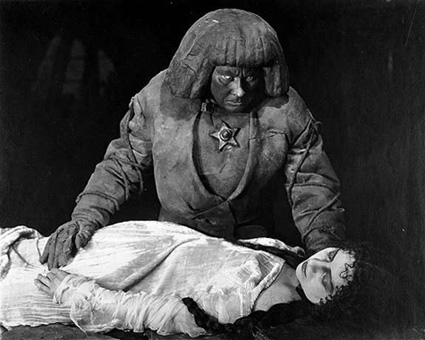The Golem meets Meyrinck in the Old Prague

- MySpace profile for the Golem
Pictures, blog, information and much more. - MySpace profile for Gustav Meyrink
Pictures, blog, interests, information and much more. - MySpace profile for The Old Prague
The Golem
In Jewish folklore, 'a golem' is an animated being created entirely from inanimate matter. In modern Hebrew the word literally means 'cocoon', but can also mean 'fool' or 'stupid'; in Yiddish it is a slang insult, meaning 'clumsy' or 'slow'. The name appears to derive from the word 'gelem', which means 'raw material'. In the Bible, 'a golem' refers to an embryonic or incomplete substance, an 'unshaped form'. Today, 'a golem' stands for an entities serving man under controlled conditions but hostile to him in others.
On the Golem MySpace, you can find the story about Rabbi Judah Loew, a 16th century rabbi of Prague:
'He is reported to have created a golem to defend the Prague ghetto of Josefov from Anti-Semitic attacks. The story of the Golem first appeared in print in 1847 in a collection of Jewish tales (...). About sixty years later, a fictional account was published by Yudl Rosenberg (1909). According to the legend, the Emperor made an edict proclaiming that the Jews in Prague were to be either expelled or killed (depending on the version of the story). A golem could be made of clay from the banks of the Vltava river in Prague. Following the prescribed rituals, the Rabbi built the Golem and made him come to life by reciting special incantations in Hebrew. The Rabbi's intention was to have the Golem protect the Jewish community from harm. As Rabbi Loew's Golem grew bigger, he also became more violent and started killing the Gentiles (non-Jews) and spreading fear. Some versions also add that the Golem turns on his creator and attacks either his creator alone or the creator and the Jews as well. In the face of the strength demonstrated and violence perpetrated by the Golem, the Emperor begs Rabbi Loew to destroy the Golem, and in return he would promise that the persecution of and violence towards the Jews would stop. The Rabbi accepted this offer. To destroy the Golem, he rubbed out the first letter of the word "emet" or "aemaeth" (God's truth) from the golem's forehead to make the Hebrew word "met" or "maeth", meaning death. It was made clear to the Emperor that the Golem of Prague's remains would be stored in a coffin in the attic of the Altneuschul in Prague, and it can be summoned again if needed. By legend, that coffin with the unformed earth inside is still there today.'
In the late nineteenth century the golem was adopted by the European mainstream. Very famous was the novel Der Golem (1915) by Gustav Meyrink, a most fascinating fantasy author and member of the Hermetic Order of the Golden Dawn: : 'In Prague an event occurred which played a providential role in Meyrink's life. Meyrink described it in the autobiographical short story "The Pilot". That day, August 14, 1892, on Assumption Eve, Meyrink, 24 years old, was standing at his table with a gun at his hand, strongly determined to shoot himself. At that moment he heard a strange scratch and someone's hand put a tiny booklet under his door. The booklet was called Afterlife. Meyrink was shocked by this dramatic coincidence and started to study the literature of the occult. Having studied theosophy, Kabbala, christian Sophiology and Eastern mysticism, he also tried to practise (in the beginning, quite naively).'
The main character of Der Golem is Athanasius Pernath, a contemporary artist from Prague: 'It is left to the reader to decide whether Pernath is simply writing down his hallucinations or gradually turning into a real golem,' says the Meyrink MySpace Page. The book inspired a classic set of expressionistic silent movies, as Paul Wegener's Golem series, of which especially The Golem: How He Came Into the World is worth mentioning here. Hollywood composer Carvin Knowles gave the classic 1920 German expressionist black and white horror film a new soundtrack. He wrote about his work on http://www.youtube.com/watch?v=5zag79w8eIQ :
'In this scene, Rabbi Loew summons the Sumerian demon Astaroth to learn the word that will bring the Golem to life -- rendered in the most arcane transliteration from Hebrew that I have ever seen, the word is "Aemath" meaning "emet" (Hebrew) or "truth".'
Later on, the golem tales saw a dramatic change and became a creation of overambitious mystics, who would inevitably be punished for their blasphemy, as in Mary Shelley's Frankenstein and the alchemical homunculus.




